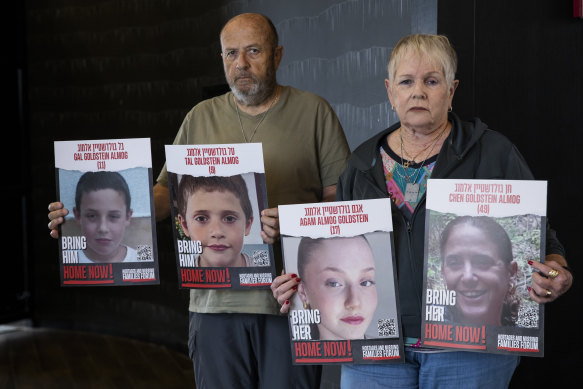Israel shows off more alleged Hamas tunnels as hostage release delayed

Save articles for later
Add articles to your saved list and come back to them any time.
Gaza City: The Israeli military has unveiled what it claims is a Hamas military facility under Gaza’s largest hospital, showing what appeared to be a subterranean dormitory to a group of foreign journalists who were given a rare glimpse inside the besieged enclave.
Dozens of soldiers escorted journalists through a narrow stone tunnel – which the military said stretched 150 metres to a series of underground bunkers beneath Al Shifa Hospital in Gaza City. Living quarters, located at the end of the tunnel, had an air conditioner, kitchen, bathroom and a pair of metal cots in a room fashioned from rusty white tiles. They appeared to be out-of-use.
“Shifa Hospital is the hugest hospital in Gaza, and it’s also the hugest terror facility of Hamas,” said Rear Admiral Daniel Hagari, the Israeli military’s chief spokesperson. “Hamas battalion commanders were conducting command-and-control, firing rockets from here.”
The Associated Press could not independently verify Hagari’s claims.
Meanwhile, the release of hostages captured by Hamas in its October 7 attack will not happen before Friday, Israel’s national security adviser and the US said, dashing the hopes of relatives that some would be freed on Thursday.
Israel and Hamas agreed on Wednesday to a ceasefire for at least four days to let humanitarian aid into Gaza and free at least 50 hostages in exchange for at least 150 Palestinians jailed in Israel.
The starting time of the truce and hostage release has yet to be officially announced. An Egyptian security source said mediators had sought a start time of 0800 GMT (7pm AEDT) on Thursday.
“The negotiations … are advancing and continuing constantly,” Israeli National Security Adviser Tzachi Hanegbi said in a statement. “The start of the release will take place according to the original agreement between the sides, and not before Friday.”
White House spokesperson Adrienne Watson said final logistical details for the release were “on track”, and was hopeful that “implementation” would begin on Friday morning.
Israel’s public broadcaster Kan, citing an unidentified Israeli official, reported there was a 24-hour delay because the agreement had not been signed by Hamas and mediator Qatar. The official said they were optimistic the deal would be carried out when it was signed.
Israeli news website Ynet reported that Israel had not yet received the names of the hostages slated for release by Hamas.
“We need to know they are alive, if they’re okay. It’s the minimum,” said Gilad Korngold, who was among those still awaiting word of missing relatives. Seven of his family members, including his three-year-old granddaughter, were taken hostage.
“I want everybody back. But I think – and it’s a very tough decision – but I think the children and women must be [first]. They are most fragile. You know, they need to get out.”
David and Varda Goldstein with photos of their grandchildren, Gal, Tal and Agam, and their mother, Chen, who were kidnapped on October 7.Credit: Getty
The 50 hostages would be released over four days at a rate of at least 10 daily, Prime Minister Benjamin Netanyahu’s office said. The truce could be extended day by day so long as an additional 10 hostages were freed each day, it said.
The agreement, the first in a nearly seven-week-long war, was reached after mediation by Qatar, the US and Egypt and seen by governments around the world as potentially easing the suffering of civilians in the Gaza Strip.
Hundreds of trucks of humanitarian, medical and fuel supplies would enter Gaza, while Israel would halt all air sorties over southern Gaza and maintain a daily six-hour daytime no-fly window in the north, Hamas said.
Terms of the Israel-Hamas ceasefire
- All fighting in Gaza halts for four days.
- Hamas will release 50 women and children held as hostages.
- In exchange, Israel will release 150 Palestinian women and children from jail.
- The truce deal will allow hundreds of trucks of humanitarian, medical and fuel aid to enter Gaza.
- Israel to extend truce by an extra day for every additional 10 hostages released by Hamas.
The war was triggered by Hamas’ cross-border attack that killed some 1200 people. In retaliation, Israel has subjected Gaza to a relentless bombardment that has killed more than 14,000 Gazans, around 40 per cent of them children, according to medical officials in the territory.
Palestinian media reported that Israeli aircraft and artillery struck Gaza’s southern city of Khan Younis in at least two waves early on Thursday.
In Israel, sirens warning of incoming rocket fire from Gaza also blared in communities near the border with the enclave, the military said. There were no reports of damage or injuries.
AP, Reuters
More coverage of the Hamas-Israel conflict
- Hamas had bigger plans on October 7: Intelligence about Hamas’ motivations reveals an intention to strike a blow of historic proportions and provoke an overwhelming Israeli response.
- Escape from chaos: An Australian father faced a heartbreaking dilemma – whether to flee Gaza to his children, or stay with his wife.
- Open letters: Mass resignations, boardroom turmoil and angry donors are some of the ways the Israel-Hamas war is filtering down into Australia’s high-powered arts world.
- Gaza’s youth: One of the cruellest ironies of war is that they are never started by children, yet it is children who suffer the most.
Get a note directly from our foreign correspondents on what’s making headlines around the world. Sign up for our weekly What in the World newsletter.
Most Viewed in World
From our partners
Source: Read Full Article

